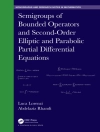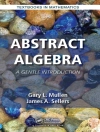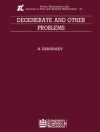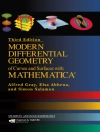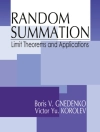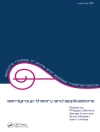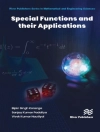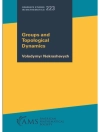A concise yet rigorous introduction to logic and discrete mathematics.
This book features a unique combination of comprehensive coverage of logic with a solid exposition of the most important fields of discrete mathematics, presenting material that has been tested and refined by the authors in university courses taught over more than a decade.
The chapters on logic – propositional and first-order – provide a robust toolkit for logical reasoning, emphasizing the conceptual understanding of the language and the semantics of classical logic as well as practical applications through the easy to understand and use deductive systems of Semantic Tableaux and Resolution. The chapters on set theory, number theory, combinatorics and graph theory combine the necessary minimum of theory with numerous examples and selected applications. Written in a clear and reader-friendly style, each section ends with an extensive set of exercises, most of them provided with complete solutions which are available in the accompanying solutions manual.
Key Features:
* Suitable for a variety of courses for students in both Mathematics and Computer Science.
* Extensive, in-depth coverage of classical logic, combined with a solid exposition of a selection of the most important fields of discrete mathematics
* Concise, clear and uncluttered presentation with numerous examples.
* Covers some applications including cryptographic systems, discrete probability and network algorithms.
Logic and Discrete Mathematics: A Concise Introduction is aimed mainly at undergraduate courses for students in mathematics and computer science, but the book will also be a valuable resource for graduate modules and for self-study.
Innehållsförteckning
Preface xvii
Acknowledgements xxi
About the Companion Website xxiii
1. Preliminaries 1
1.1 Sets 2
1.1.1 Exercises 7
1.2 Basics of logical connectives and expressions 9
1.2.1 Propositions, logical connectives, truth tables, tautologies 9
1.2.2 Individual variables and quantifiers 12
1.2.3 Exercises 15
1.3 Mathematical induction 17
1.3.1 Exercises 18
2. Sets, Relations, Orders 20
2.1 Set inclusions and equalities 21
2.1.1 Properties of the set theoretic operations 22
2.1.2 Exercises 26
2.2 Functions 28
2.2.1 Functions and their inverses 28
2.2.2 Composition of mappings 31
2.2.3 Exercises 33
2.3 Binary relations and operations on them 35
2.3.1 Binary relations 35
2.3.2 Matrix and graphical representations of relations on finite sets 38
2.3.3 Boolean operations on binary relations 39
2.3.4 Inverse and composition of relations 41
2.3.5 Exercises 42
2.4 Special binary relations 45
2.4.1 Properties of binary relations 45
2.4.2 Functions as relations 47
2.4.3 Reflexive, symmetric and transitive closures of a relation 47
2.4.4 Exercises 49
2.5 Equivalence relations and partitions 51
2.5.1 Equivalence relations 51
2.5.2 Quotient sets and partitions 53
2.5.3 The kernel equivalence of a mapping 56
2.5.4 Exercises 57
2.6 Ordered sets 59
2.6.1 Pre-orders and partial orders 59
2.6.2 Graphical representing posets: Hasse diagrams 61
2.6.3 Lower and upper bounds. Minimal and maximal elements 63
2.6.4 Well-ordered sets 65
2.6.5 Exercises 67
2.7 An introduction to cardinality 69
2.7.1 Equinumerosity and cardinality 69
2.7.2 Exercises 73
2.8 Isomorphisms of ordered sets. Ordinal numbers 75
2.8.1 Exercises 79
2.9 Application: relational databases 80
2.9.1 Exercises 86
3. Propositional Logic 89
3.1 Propositions, logical connectives, truth tables, tautologies 90
3.1.1 Propositions and propositional connectives. Truth tables 90
3.1.2 Some remarks on the meaning of the connectives 90
3.1.3 Propositional formulae 91
3.1.4 Construction and parsing tree of a propositional formula 92
3.1.5 Truth tables of propositional formulae 93
3.1.6 Tautologies 95
3.1.7 A better idea: search for a falsifying truth assignment 96
3.1.8 Exercises 97
3.2 Propositional logical consequence. Valid and invalid propositional inferences 101
3.2.1 Propositional logical consequence 101
3.2.2 Logically sound rules of propositional inference. Logically correct propositional arguments 104
3.2.3 Fallacies of the implication 106
3.2.4 Exercises 107
3.3 The concept and use of deductive systems 109
3.4 Semantic tableaux 113
3.4.1 Exercises 117
3.5 Logical equivalences. Negating propositional formulae 121
3.5.1 Logically equivalent propositional formulae 121
3.5.2 Some important equivalences 123
3.5.3 Exercises 124
3.6 Normal forms. Propositional resolution 126
3.6.1 Conjunctive and disjunctive normal forms of propositional formulae 126
3.6.2 Clausal form. Clausal resolution 129
3.6.3 Resolution-based derivations 130
3.6.4 Optimizing the method of resolution 131
3.6.5 Exercises 132
4. First-Order Logic 135
4.1 Basic concepts of first-order logic 136
4.1.1 First-order structures 136
4.1.2 First-order languages 138
4.1.3 Terms and formulae 139
4.1.4 The semantics of first-order logic: an informal outline 143
4.1.5 Translating first-order formulae to natural language 146
4.1.6 Exercises 147
4.2 The formal semantics of first-order logic 152
4.2.1 Interpretations 152
4.2.2 Variable assignment and term evaluation 153
4.2.3 Truth evaluation games 156
4.2.4 Exercises 159
4.3 The language of first-order logic: a deeper look 161
4.3.1 Translations from natural language into first-order languages 161
4.3.2 Restricted quantification 163
4.3.3 Free and bound variables. Scope of a quantifier 164
4.3.4 Renaming of a bound variable in a formula. Clean formulae 165
4.3.5 Substitution of a term for a variable in a formula. Capture of a variable 166
4.3.6 Exercises 167
4.4 Truth, logical validity, equivalence and consequence in first-order logic 171
4.4.1 More on truth of sentences in structures. Models and countermodels 171
4.4.2 Satisfiability and validity of first-order formulae 172
4.4.3 Logical equivalence in first-order logic 173
4.4.4 Some logical equivalences involving quantifiers 174
4.4.5 Negating first-order formulae 175
4.4.6 Logical consequence in first-order logic 176
4.4.7 Exercises 180
4.5 Semantic tableaux for first-order logic 185
4.5.1 Some derivations using first-order semantic tableau 186
4.5.2 Semantic tableaux for first-order logic with equality 189
4.5.3 Discussion on the quantifier rules and on termination of semantic tableaux 189
4.5.4 Exercises 191
4.6 Prenex and clausal normal forms 195
4.6.1 Prenex normal forms 195
4.6.2 Skolemization 197
4.6.3 Clausal forms 198
4.6.4 Exercises 199
4.7 Resolution in first-order logic 201
4.7.1 Propositional resolution rule in first-order logic 201
4.7.2 Substitutions of terms for variables revisited 201
4.7.3 Unification of terms 202
4.7.4 Resolution with unification in first-order logic 204
4.7.5 Examples of resolution-based derivations 205
4.7.6 Resolution for first-order logic with equality 207
4.7.7 Optimizations of the resolution method for first-order logic 207
4.7.8 Exercises 207
4.8 Applications of first-order logic to mathematical reasoning and proofs 211
4.8.1 Proof strategies: direct and indirect proofs 211
4.8.2 Tactics for logical reasoning 215
4.8.3 Exercises 216
5. Number Theory 219
5.1 The principle of mathematical induction revisited 220
5.1.1 Exercises 222
5.2 Divisibility 224
5.2.1 Basic properties of divisibility 224
5.2.2 Division with a remainder 224
5.2.3 Greatest common divisor 225
5.2.4 Exercises 227
5.3 Computing greatest common divisors. Least common multiples 230
5.3.1 Euclid’s algorithm for computing greatest common divisors 230
5.3.2 Least common multiple 232
5.3.3 Exercises 233
5.4 Prime numbers. The fundamental theorem of arithmetic 236
5.4.1 Relatively prime numbers 236
5.4.2 Prime numbers 237
5.4.3 The fundamental theorem of arithmetic 238
5.4.4 On the distribution of prime numbers 239
5.4.5 Exercises 240
5.5 Congruence relations 243
5.5.1 Exercises 246
5.6 Equivalence classes and residue systems modulo n 248
5.6.1 Equivalence relations and partitions 248
5.6.2 Equivalence classes modulo n. Modular arithmetic 249
5.6.3 Residue systems 250
5.6.4 Multiplicative inverses in Zn 251
5.6.5 Exercises 251
5.7 Linear Diophantine equations and linear congruences 253
5.7.1 Linear Diophantine equations 253
5.7.2 Linear congruences 254
5.7.3 Exercises 256
5.8 Chinese remainder theorem 257
5.8.1 Exercises 259
5.9 Euler’s function. Theorems of Euler and Fermat 261
5.9.1 Theorems of Euler and Fermat 262
5.9.2 Exercises 264
5.10 Wilson’s theorem. Order of an integer 266
5.10.1 Wilson’s theorem 266
5.10.2 Order of an integer 266
5.10.3 Exercises 267
5.11 Application: public key cryptography 269
5.11.1 About cryptography 269
5.11.2 The idea of public key cryptography 269
5.11.3 The method RSA 270
5.11.4 Exercises 271
6. Combinatorics 274
6.1 Two basic counting principles 275
6.1.1 Exercises 281
6.2 Combinations. The binomial theorem 284
6.2.1 Counting sheep and combinations 284
6.2.2 Some important properties 286
6.2.3 Pascal’s triangle 287
6.2.4 The binomial theorem 287
6.2.5 Exercises 289
6.3 The principle of inclusion-exclusion 293
6.3.1 Exercises 296
6.4 The Pigeonhole Principle 299
6.4.3 Exercises 302
6.5 Generalized permutations, distributions and the multinomial theorem 304
6.5.1 Arranging nondistinct objects 304
6.5.2 Distributions 306
6.5.3 The multinomial theorem 308
6.5.4 Summary 310
6.5.5 Exercises 311
6.6 Selections and arrangements with repetition; distributions of identical objects 312
6.6.1 Selections with repetition 312
6.6.2 Distributions of identical objects 314
6.6.3 Arrangements with repetition 315
6.6.4 Summary 316
6.6.5 Exercises 316
6.7 Recurrence relations and their solution 318
6.7.1 Recurrence relations. Fibonacci numbers 318
6.7.2 Catalan numbers 319
6.7.3 Solving homogeneous linear recurrence relations 322
6.7.4 Exercises 327
6.8 Generating functions 329
6.8.1 Introducing generating functions 329
6.8.2 Computing coefficients of generating functions 332
6.8.3 Exercises 335
6.9 Recurrence relations and generating functions 337
6.9.1 Exercises 341
6.10 Application: classical discrete probability 343
6.10.1 Common sense probability 343
6.10.2 Sample spaces 343
6.10.3 Discrete probability 345
6.10.4 Properties of probability measures 346
6.10.5 Conditional probability and independent events 348
6.10.6 Exercises 352
7. Graph Theory 356
7.1 Introduction to graphs and digraphs 357
7.1.1 Graphs 357
7.1.2 Digraphs 364
7.1.3 Exercises 367
7.2 Incidence and adjacency matrices 370
7.2.1 Exercises 374
7.3 Weighted graphs and path algorithms 377
7.3.1 Dijkstra’s algorithm 378
7.3.2 The Floyd-Warshall algorithm 381
7.3.3 Exercises 383
7.4 Trees 385
7.4.1 Undirected trees 385
7.4.2 Computing spanning trees: Kruskal’s algorithm 388
7.4.3 Rooted trees 390
7.4.4 Traversing rooted trees 392
7.4.5 Exercises 393
7.5 Eulerian graphs and Hamiltonian graphs 395
7.5.1 Eulerian graphs and digraphs 396
7.5.2 Hamiltonian graphs and digraphs 398
7.5.3 Exercises 400
7.6 Planar graphs 404
7.6.1 Exercises 408
7.7 Graph colourings 411
7.7.1 Colourings 411
7.7.2 The four- and five-colour theorems 413
7.7.3 Exercises 414
Index 419
Om författaren
Willem Conradie, University of Johannesburg, South Africa.
Valentin Goranko, University of Stockholm, Sweden.


